Published
on 14
Apr 2020
|
All rights reserved.
|
|
|
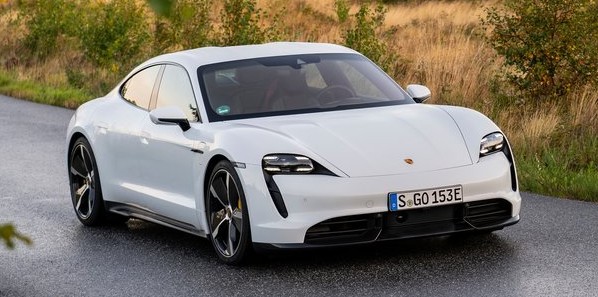
|
|
A
Turbo without turbocharging, but loads of fun nonetheless.
|
|
Funny, these days a 911
Carrera can have turbos, while Taycan Turbo and Turbo S have none. In
fact, not even an engine. This is the first ever Porsche without an
engine. It is also the most controversial Porsche since 2002, when it
built its first SUV, Cayenne. More worrying, the Taycan is designed
to be a 4-seat sports car rather than something more practical and
compromised like Cayenne or Panamera. Without the sound, the smell and
the character of a Porsche engine, how can it be recognized as a true
Porsche? That’s how we thought when the Mission E concept debuted in
2015 Frankfurt motor show. 4 years later, the production car finally
goes on sale, and it wipes out most of our doubts.
I am glad that the Taycan is not designed to be a smaller Panamera, but
closer to a sports car. Think the 4-seater version of 911, albeit in
electric form. Even without driving the car, this is evident from its
exterior design. Isn’t this waterdrop shape familiar? Ditto the curvy
flanks, broad shoulders and the shape of the side windows. It could
have been even closer to the 911 if it adopted round headlamps, but a
vastly different design is chosen to give it a distinctive character.
While the Panamera looks heavy and bulky, the Taycan looks
sportscar-light, thanks to a very low and flowing waist line. Its
roof is rather low, too, 45mm lower than Panamera. However, at nearly 5
meters long and 2 meters wide, this is actually a large car. Heavier
than the Panamera, too, as it can tip the scale at more than 2300kg.
Yes, that’s Bentley-heavy, blame to the 630kg worth of battery. But the
streamline shape does return an outstanding drag coefficient. At 0.22,
the Taycan Turbo is pretty much unbeatable by any production cars.
Turbo S is slightly less remarkable at 0.25, due to wider tires and
more cooling.
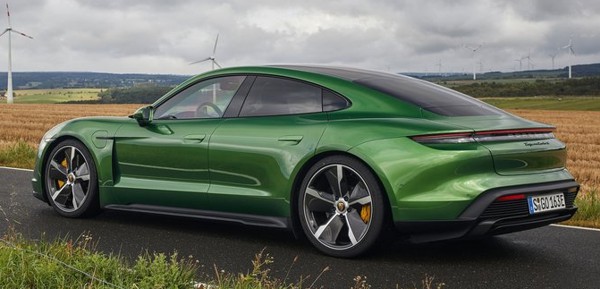
|
|
It
is Bentley-heavy, blame to the 630kg worth of battery.
|
|
The
Taycan debuts with an all-new platform called J1, which will be shared
with the Cross Turismo version of the car (think a high-riding
hatchback) and Audi e-Tron GT. Although Porsche gained experience of
electrification in 918 Spyder, doing a full electric car is still a big
challenge. Frankly, the Taycan has nothing innovative. Tesla Model S
has already set the formula 8 years ago, and you might say that car is
hardly slower than the latest Porsche – both cars do 0-60 in about 2
and a half seconds and 0-100 just over 6 seconds. The point is, Porsche
needs to make the Taycan drives like a Porsche, not just shine in a
straight line but also maneuvers, stops and feels like a Porsche. That
is the real challenge, as a 2300kg machine has no rights to drive like
a 911. That’s why the program took 4 years from concept car to
production. Porsche even goes as far as designing and building its own
electric motors, inverter and gearbox for the electric powertrain, not
outsourcing technologies from suppliers like Rimac.
The J1 platform follows Tesla to have its battery mounted in the
floorpan to achieve the lowest possible center of gravity, which is
lower than that of the 911, unsurprisingly. However, the drawback of
this arrangement is a slightly elevated cabin, which might not bother a
sedan like Tesla, but is deemed to be unacceptable to a Porsche.
Porsche wants people feel like driving a sports car, so a low mounting
point for seats is a must. To realize the Taycan’s low and swoopy roof
line, the rear seats shall be mounted low, too. If the rear seats are
mounted low, rear passengers will sit with bent knees and feel very
uncomfortable. Therefore, Porsche carves out part of the skateboard
floor to provide foot room to the rear passengers. To compensate,
another stack of battery is added under the rear seat cushion, keeping
the battery capacity to a Tesla-rivalling 93.4kWh.
Like other Porsche sports cars, the Taycan’s body is constructed as a
steel and aluminum hybrid monocoque. The main structure is mostly
high-strength steel, while front and rear subframes, crash structures,
suspension towers, doors and most of the body skins are aluminum in the
form of stamping, casting or extrusion. The battery is protected by
aluminum casing. Torsional rigidity is unspecified, but you won’t doubt
Porsche. Front-to-rear weight distribution is a perfect 49:51, thanks
to having an electric motor at each axle.
|
|
|
J1
platform has rear footwell carved out but still accommodates 93.4kWh
battery.
|
|
Each motor comes with its own inverter, but the rear motor
is about twice as powerful as the front motor. These permanent magnet
motors are more energy efficient than the induction motor of Tesla
Model S, which needs to energize stator windings to generate magnetic
field. The downside is the magnets use more rare earth to make, and the
mining of rare earth is usually environmental-unfriendly, but this is
the current trend of EV development. The inhouse-built motors employ
“hairpin winding” technology, which can pack more windings in a given
space thus more power-dense. The front motor is integral with an open
differential and a fixed ratio transmission. The rear axle motor is
linked to an electronic LSD like most other Porsches to provide torque
vectoring (i.e. PTV Plus). Unusual for an EV, the rear motor works with
a 2-speed gearbox, whose first gear is optimized for full-power launch
from a standstill, while second gear takes care of most driving. This
ensures the Taycan to achieve supercar acceleration without
compromising energy efficiency.
There are 3 Taycan models to choose from: 4S, Turbo and Turbo S. All
have 2-motor setup, but performance and range differ them. Both the
Turbo and Turbo S produce a combined output of 625hp, but a bigger
inverter in the Turbo S allows an overboost to 761hp and 774 lbft of
torque, while the overboost of Turbo manages 680hp and 627 lbft. Mind
you, the overboost lasts only 2.5 seconds, then reverts to 625hp for
another 10 seconds, but these short periods are sufficient to take the
Taycans from rest to 60mph and 124mph, respectively. More specific, the
Turbo S is good for 0-60 in 2.6 seconds, 0-100 in 6.3 seconds and
0-124mph in 9.8 seconds, which is supercar performance. The lesser
Turbo is marginally slower, but still easily quicker than any other
production 4-doors in the world, including the mighty Mercedes-AMG GT63
S! Moreover, with a top speed regulated at 162mph, you won't find the
usual degradation of performance at higher speeds.
However, what separates the Taycan from Tesla is that it is designed to
sustain high performance. While Tesla drivers might feel proud to do a
sprint of 0-60 in 2.4 seconds, Taycan drivers can do it repeatedly, no
need to wait for its battery to cool down. Car and Driver tested the
Taycan Turbo S for full-bore ¼-mile acceleration 15 times in
succession and found it kept its performance almost unchanged. Under
the same conditions, the Tesla Model S Performance has its performance
drops massively from the 3rd run. By the 6th run, it took 7 seconds to
go from 0-60. Next time, if you want to challenge Tesla with your Golf
GTI, ask your opponent to run 6 times, haha.
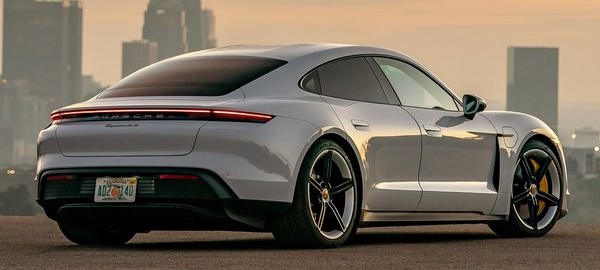 |
|
|
Turbo
S is good for 0-60 in 2.6 seconds and 0-100 in 6.3 seconds, which is
supercar performance.
|
|
The
entry-level Taycan 4S has a less powerful rear motor for a combined
output of 435hp. It is good for 0-60 in 3.9 seconds, about equal to a
Tesla Model S long range (3.7 seconds) once you consider the
conservative approach of Porsche’s claims. However, it employs a
smaller, 79.2kWh battery to keep cost down. This drops its WLTP driving
range from 450km of the Turbo and 412km of the Turbo S to a still
pretty practical 407km. You may opt for the larger battery at extra
cost, but still, Tesla offers significantly more range.
On the plus side, the Taycan has quicker charging if you can find a
suitable charging facility. This is because it employs an 800V and
270kW charging system. 80 percent charge can be done in merely 22.5
minutes, much quicker than that achievable by Tesla’s 480V and 150kW
system. Moreover, the higher voltage allows a lower charging current,
thus the charging cables can be made narrower, saving considerable
weight. Having said that, Tesla’s charging stations are far more
popular. It may take many years for the infrastructure to build up.
Starting at £83,000, the 4S is definitely the most tempting
choice, as it is only £2,000 more than the Tesla Model S long
range. The Turbo and Turbo S cost £116,000 and £139,000,
respectively, significantly more than the range-topping Tesla
(£96,000). It goes without saying Porsche is a prestige brand.
The suspensions of Taycan are adapted from Panamera, but not exactly
the same parts. They consist of aluminum double-wishbones up front and
aluminum multi-link setup at the rear, supported with 3-chamber
height-adjustable air springs, PASM adaptive dampers and optional PDCC
active anti-roll bars. The Turbo S gets 4-wheel steering and ceramic
brakes as standard. It adopts also larger, 21-inch wheels and wider
tires. Frankly, ceramic brakes are not necessary, as Porsche says 90
percent of braking is done by regenerative braking in normal driving.
You do need a lot of mechanical braking when driving on a track, but
the tungsten carbide-coating steel brakes on the Turbo seems to work
just as fine, and it provides a more consistent response at cold.
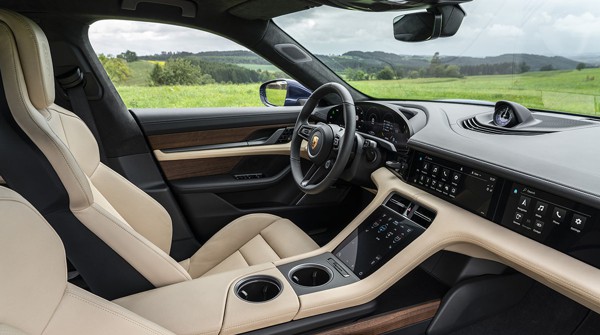
|
|
Too
many screens and too few buttons, but build quality is premium.
|
|
Expectedly,
the car has 2 luggage compartments – the front offers 81 liters while
the rear is quite modest at 366 liters. Inside the cabin, its dashboard
design mirrors that of the classic air-cooled 911s, although the
instrument reading is now realized by a 16.8-inch TFT screen. The
latter looks quite classy, as it is curved and free of cowl. The center
console has a 10.9-inch touchscreen for infotainment, while the sloping
transmission tunnel features another 8.4-inch touchscreen for climate
control and lets you input things more easily. In addition to the
optional 10.9-inch touchscreen at the glovebox area for the passenger
to play, virtually the entire dashboard is occupied by screens. Build
quality is high, just as you would expect for a Porsche. On the
downside, there are no physical buttons at all, not even air-con. All
controls are done at the touchscreens, which is unnecessarily
complicated.
Driving position is excellent. You sit lower than other saloons but a
tad higher than in a 911. Forward visibility is great, while rearward
is not so. The small steering wheel feels as intimate in hands as in
Porsche sports cars. The seat is comfortable yet supportive. The
individual rear seats accommodate a pair of passengers up to 6ft.
Legroom is good, but headroom is a little compromised by the sloping
roof line. However, order the panoramic roof will free up a couple of
inches, while lightening the ambience of the cabin.
The Taycan is built at the Zuffenhausen hometown with an installed
capacity of 20,000 units annually (but could be doubled by adding
shifts), not in other Volkswagen facilities or Magna Steyr, so it is a
true Porsche.
|
|
|
Rear
seats fit adults up to 6ft tall, but panoramic roof could free up a
couple of inches.
|
|
On the Road
Just as any EVs, the Taycan starts and cruises at low speed in near
silence. On highway, the slippery body generates little wind noise, but
road noise is more intrusive in the Turbo S with wider tires. Engage
Sport or Sport+ mode and launch the car in full power, the electric
motor emits a high-pitch whine that is actually quite exciting to ears.
Acceleration is staggering, so explosive, pressing your head hard on
the headrest. Then the 2-speed transmission shifts at around 45mph,
interrupting the power flow momentarily, then sending a kick to your
body and continue its relentless acceleration to well over 3-figures
speed. As a result, what intended to enhance efficiency turns out to
enhance the drama, making the Taycan feel more exciting than the
equally fast Tesla in acceleration. No, it is still not quite as
exciting as driving an AMG GT63 S, because it lacks an angry exhaust
roar. And without controlling gearshift, you feel less engaging.
Although the Taycan can regenerate 360hp from braking, it does not
offer one-pedal driving mode, as no keen drivers like to drive the car
in this way. The braking power is excellent. Despite carrying 250 extra
kilograms compared with AMG GT63 S, Car and Driver found the Turbo S
stops from 70mph in the same 155 ft with ceramic brakes. Brake pedal
feel is largely good, but you can sense different responses between
regenerative braking and mechanical braking, which is not good enough
for a Porsche – the 918 Spyder seemed to feel more natural, but then
again it uses far lighter regenerative braking than the Taycan. The
steel brakes of Turbo might stops less quickly, but it provides a
meatier feel.
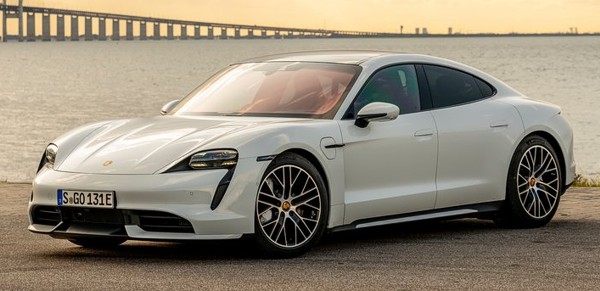
|
|
As
far as a battery performance car is concerned, it is right now the
benchmark.
|
|
Unlike
Tesla, the Taycan corners as good as you can ask from a performance
saloon. Its steering turns with the same precision, linearity and
weighting as that of the 911, if not as much detailed feedback due to
the mass over and the torque passing through the front axle. With the
help of 4-wheel steering, it turns in sharply, too. Grip and traction
are phenomenal. Body control is terrific, displaying less roll in
corner than the Panamera. The ride is also tauter than the latter, if
slightly less comfy as a result. It all feels like a proper Porsche,
certainly much lighter than its 2300kg mass suggested. In fact, it
feels lighter and better balanced than the Panamera.
That is strange, as the Panamera Turbo is quicker to lap Nurburgring,
taking 7:38 compared with 7:42 of the Taycan Turbo S. In fact, there
are a few other performance 4-seaters bettering the Taycan, too, such
as BMW M5 Competition (7:36), Alfa Giulia QF (7:32) and the current
class-leader, AMG GT63 S (7:25). Driving flat out on a circuit, you do
feel the extra mass a little, especially in sudden transition. Car and
Driver’s test data also reveals a lateral acceleration slightly less
remarkable than the AMG GT63 S (0.99g vs 1.03g, although not on the
same day). The extra mass might have subtle effects to lap time.
Moreover, Nurburgring is a very long circuit, putting the sustainable
output of its battery power in question. On the road, however, the
Taycan feels absolutely quick.
The Taycan has a lot to like and admire. As far as a battery
performance car is concerned, it is right now the benchmark. The
drawback remains to be high prices, limited range and lacking the sound
and driver engagement of conventional performance cars. Still, it is a
respectable first step towards electrification. It proves that even
without an engine, an EV could be exciting to drive. Just don’t call it
Turbo please.
|
Verdict:      |
Published
on 15
Jun 2024
|
All rights reserved.
|
|
Taycan 2024 update
|
|
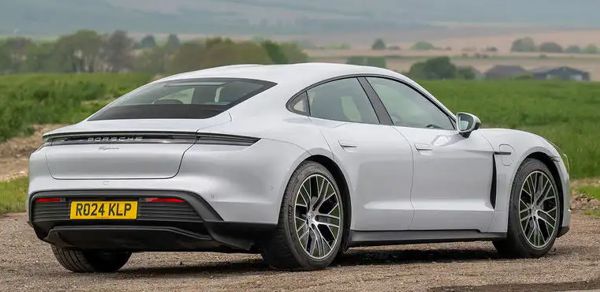
|
|
Updated
Taycan gets longer range, faster charging and even more performance.
|
|
After 4 years on the
market, Porsche Taycan receives the first update. It is pretty
comprehensive and should answer customers' wishes, such as more range,
faster charging and even more performance.
First of all, all models get a larger capacity battery. The battery on
the base Taycan has grown from 79 to 89 kWh, while pricier models get
105 instead of 93 kWh (all are gross figures). Despite that, the
battery is actually a little bit lighter, since it uses more nickel and
less cobalt in its chemistry, which results in higher energy density.
Moreover, the copper conductors simplified, the number of fuses reduced
and the protection undertray has been converted from aluminum to
composite materials, meaning the larger battery pack is 10 kg lighter
than before even though its energy capacity is boosted by 13 percent.
That’s progress.
Meanwhile, charging is faster. Although the outgoing Taycan was already
pretty good at 270kW, the new car has lifted the maximum charge rate to
320kW. Moreover, the
charging curve gets flatter, so it can sustain higher charge current
for most of the time. This is helped further by improved thermal
management, which uses a new heat pump and an 800V air-conditioning
compressor to bring the battery up to operating temperature quicker.
This means, a 10-80 percent charge takes only 18 minutes, or half the
time of the old car.
Not only it gets more battery, but the new car uses energy more
efficiently, too. This is contributed by improving the 4WD strategy
(now the front motor is disengaged more often), a more efficient rear
motor, inverter, battery and heat pumps, tires with lower rolling
resistance and 30 percent more powerful regenerative braking. As a
result, driving range is boosted by 35 percent. Now the Turbo S has a
WLTP range of 634 km or 394 miles, a massive improvement from the
previous 469 km or 291 miles.
As for performance, in response to ever stiffer competition – even now
a Hyundai is good for 0-60 in 3.3 seconds, remember – all Taycans bar
the base rear-drive model get more power from a new rear axle motor
(see specification table below). In particular, the Turbo S offers
nearly 1000 horsepower on “overboost” ! It will sprint from rest to 60
mph in less than 2.3 seconds and 124 mph in 7.7 seconds – the latter is
more than 2 seconds quicker than the old model ! If the Taycan were a
combustion-engined car, such a huge leap would have been impossible,
certainly impossible with modifications so subtle.
As for chassis, we see some significant changes as well, most notably a
standard 2-chamber air suspension with broader range of adjustment and
the optional active ride suspension. The latter has just made debut on
Panamera recently, uses quick-acting hydraulic pumps to push or pull
the damper struts to keep the car level on undulations or during
cornering. In other words, it is a true active suspension.
On the road, the new Taycan is better in every respect. Naturally, the
longer range and quicker charging are the most significant improvement,
while the extra performance is only the icing of the cake. Frankly, the
Taycan has always been super-fast, especially the Turbo and Turbo S,
but it doesn’t hurt to get even faster, especially when there is no
drawback to take. As for ride and handling, the active ride suspension
contributes to a miraculously composed manner (more on that in the
review of Taycan Turbo GT). Otherwise, the Taycan doesn’t feel much
different from the outgoing version. It is still incredibly good to
drive for a heavy EV, although you might argue that Hyundai Ioniq 5N is
now even more exciting.
The only downside is pricing. 4 years ago, the Taycan 4S, Turbo and
Turbo S cost you £83K, £116K and £139K, respectively.
Now they inflate to £96K, £134K and £161K,
respectively, representing a jump of 16 percent.
|
Verdict:      |
Published
on 15
Jun 2024
|
All rights reserved.
|
|
Taycan Turbo GT
|
|
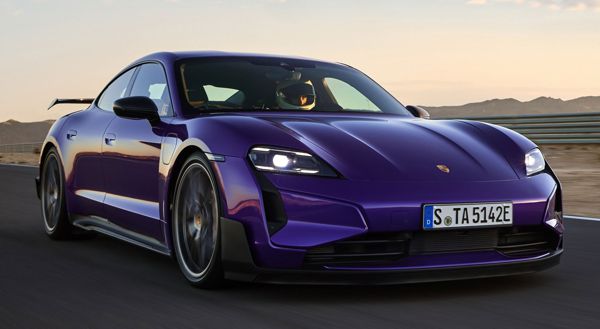
|
|
To
beat Tesla's Nurburgring record, Porsche goes to the extreme of
ditching rear seats.
|
|
Hampered by its substantial
weight, the electric Taycan is not supposed to be a track car. Somehow,
Tesla started the war first by breaking the Nurburgring lap record for
production electric cars last year. A tri-motor Model S Plaid equipped
with track package set a new record at 7:25, 7 seconds less than Taycan
Turbo S did a few years back at its backyard track. How can Porsche
stand that insult? If not the presence of Tesla, I think Porsche would
not have built this track-oriented version of Taycan.
Naturally, the Taycan Turbo GT sits at the top of the model tree and
pushes its already high prices higher again – £186,000, or
£25K more than the Turbo S. Whether it is worth this extra, we
shall see.
In standard trim, modifications are not that dramatic. Unlike Tesla,
the Porsche keeps using 2 motors, and they are identical to the lesser
models – although the latter have been upgraded recently. Instead,
extra power is released by using a more powerful silicon carbide
inverter, whose maximum output is lifted from 600A to 900A. With launch
control engaged, the car can produce 1034 horsepower and 988 pound-foot
of thrust, or even 1108 horsepower for 2 seconds. Don't laugh, that
short moment of overboost is already sufficient to propel the car from
0-60 mph in an official 2.15 seconds. Considering the last Turbo S
managed the same sprint two-tenths quicker than official figure, I
would say a good chance to see the Turbo GT can do it under 2 seconds
in road tests.
However, more astonishing is that it takes only 6.4 seconds to reach
124 mph (200km/h), which is 3.4 seconds quicker than the last Turbo S.
A 911 Turbo S won’t see which way it goes as it trails the electric car
by 2 and a half seconds. It even outruns a Ferrari SF90 and McLaren
Senna to 124 mph, which is not bad for something weighing in the order
of Bentley. Meanwhile, by using a taller second gear in its 2-speed
transmission, the GT has its top speed lifted from 162 to a respectable
190 mph. And then the most important Nurburgring lap time: 7:07.55.
Mission accomplished.
It must be said that all performance figures mentioned above are
associated with Weissach pack, which is no cost option. This brings
lightweight treatment as well as upgraded aero and track-oriented
Pirelli P Zero Trofeo RS tires. It goes so extreme that it has the rear
seats ditched entirely and replaced with a carbon-fiber parcel shelf,
turning the Taycan into a 4-door 2-seater, ridiculously. Apart from
losing rear seats, Weissach pack introduces lighter glass, cuts sound
insulation, ditches floor mats, rear audio speakers, analogue clock and
even one of the USB charging ports for a total weight saving of 70 kg.
Mind you, 2220 kg is still a lot of weight. The pack also introduces a
fixed carbon-fiber rear wing instead of active rear spoiler to boost
downforce to 220 kg.
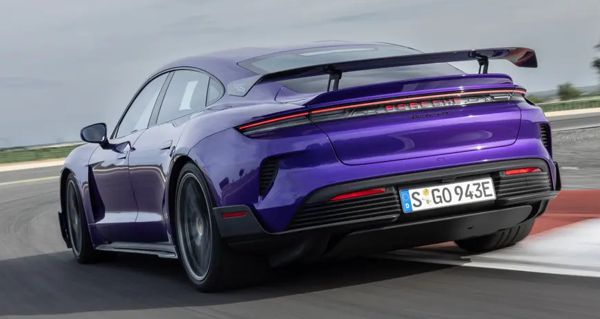
|
|
The
Taycan GT is only good to drive up to a point. It brings you a smile
but won’t make you laugh and scream. |
|
Although the standard Turbo GT is not quite as extreme, it still gets
lighter forged alloy wheels, lighter brake components, CFRP bucket
seats and ditches the soft-closing mechanism of tailgate to make the
car marginally lighter than the existing Turbo S. However, its aero
kits are rather subtle, limited to a Gurney flap mounted behind the
active rear spoiler. Visually, both GT cars can be distinguished from
lesser models by the deeper air dam with vertical winglets at either
side.
All Turbo GTs are fitted with ceramic brakes and Porsche’s new active
ride suspension as standard. The latter – first introduced by Panamera
recently – is truly active suspension. Each damper has a hydraulic pump
to adjust the force acting on each suspension, so that it can have
anti-roll bars ditched. It is power-consuming, about 34 hp, and adds 30
kilograms to the car, but its effect is very obvious, allowing the
Taycan to ride over bumps and undulations calmly, keeping the car flat
and tidy. Pitch and roll have been reduced significantly, benefiting
not only ride comfort but traction and grip as well. On the downside,
you might feel a little artificial as pitch and roll are part of the
feedback that keen drivers want. This is why the active suspension is
not used on Porsche’s sports cars.
On the road, the standard GT retains the character of all Taycans. Its
steering feels precise and true. Its braking is powerful, although the
pedal has a soft initial response before switching to mechanical
braking. Thanks to the active ride suspension, cornering is remarkably
flat, yet the ride is composed. Its chassis does a good job to disguise
its substantial weight.
However, you might say the same things to the lesser Taycans. Where the
GT matters is track performance. If you push the standard GT harder on
a track, its road-oriented P Zero R tires starts complaining. The front
end loses grip first, then understeer enters the scene. The active
suspension might be capable to suppress body motions, but ultimately
the tires fail to deny the 2.3-ton car from laws of physics.
Then you try the Weissach pack car. Its track tires offer significantly
more grip and has the GT transformed. You can go harder in corner,
brake later and turn-in more aggressively. The car resists understeer
much better and feels a lot more balanced at the limit. The steering
feels a little heavier and the brakes a little more progressive, too.
However, ultimately when the car runs out of grip, it falls out
abruptly and fails to slide at your will. While a true Porsche GT car
like GT3 and GT4 tempts you to exploit and go beyond its limit of
adhesion and then rewards you with close interaction, the Taycan GT is
only good to drive up to a point. It brings you a smile but won’t make
you laugh and scream.
So what’s the point of building a 4-door 2-seater track car when it is
not half as exciting as something weighing and costing half? The answer
is again to beat Tesla, regretfully.
|
Verdict:     |
|